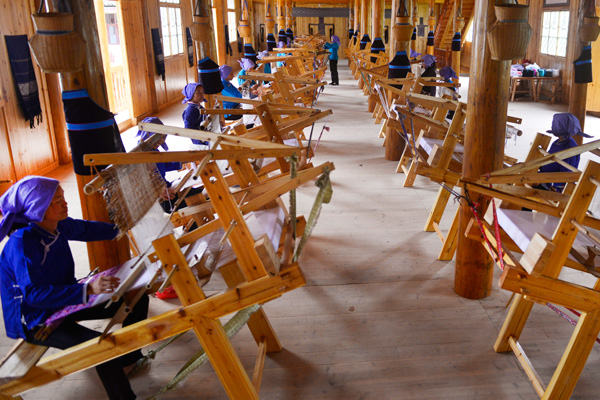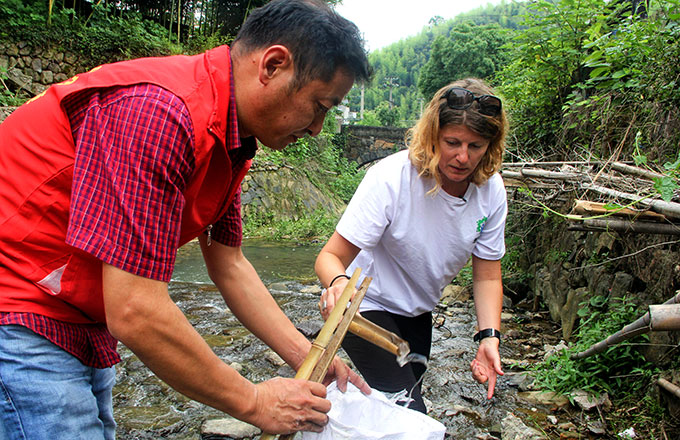Dong brocade weaver saves a delicate heritage
 |
|
Women weave Dong brocade in Wenpo village in June.[Photo/Xinhua] |
A delicate piece of Dong brocade gradually comes to life under Su Tianmei's hands, with the squeaks of an old manual loom.
"You have to move your arms and feet at the same time while weaving," Su said as she operated the loom and explained the technique to female villagers gathered around her to learn the craft.
Su, a delegate to the 19th National Congress of the Communist Party of China, dreams of carrying forward the Dong brocade-known locally as dongjin-and using the craft to help bring her neighbors out of poverty.
The brocade, known for its rich colors and exquisite patterns, has been handed down for more than 2,000 years from mothers to daughters in the Dong ethnic group. But it has been dwindling gradually in Wenpo village, Tongdao Dong autonomous county, Hunan province, in recent years. Many women have left the mountain village in search of employment in far-away cities.
Su, however, said she was born with a passion for brocade. She started learning from her mother at age 12, and she could complete a piece of work independently by the time she was 15.
"The work is time-consuming and labor-intensive," she said. "It usually takes a skilled weaver almost a month to complete a scarf.
"The income from weaving was unstable, so my husband alone had to support the family in the early years. Once he was so stressed that he wanted to set my loom on fire."
But Su never gave up her dream. Over the years, she has visited elderly people in the village to learn different patterns. She also cooperates with Hunan University's School of Design and Art in researching Dong brocade and innovating new skills and patterns to meet the demands of the market.
In 2008, Dong brocade was listed in China as an intangible cultural heritage at the national level, and Su was named the inheritor. A year later, Su used her savings to establish the Xiongguan Dong brocade workshop to help local women improve their weaving skills.
"Even migrant workers in cities came back when they heard that Dong brocade weaving can make money," Su said. "Dong women have basic weaving skills, but they need to improve their quality."
Whenever she starts a class, the weaving room is crowded with women, some from nearby communities.
"It is a unique craft passed down from our ancestors, and we can't afford to lose it," she said. "What's more, my fellow villagers can make a living by weaving-and they can tend to their families at the same time."
More than 4,000 women have learned the craft from Su. Many weave at home to earn extra money.
"Our family used to rely totally on the income of my husband, who is a city laborer," said Su Nianli, a mother of two sons. "Now I can earn about 3,000 yuan ($450) every month from weaving. We built a new house last year."
With the support of the local government, Su created a company in 2015 with about 100 workers. They produce about 20,000 Dong brocade products each year, but the demand is even greater.
Over the years, Su has attended many international exhibitions to show her work, including the 2010 Shanghai World Expo, where her 3-by-1.5-meter spider-pattern piece commanded a high price.
Zhang Yi contributed to this story.






















